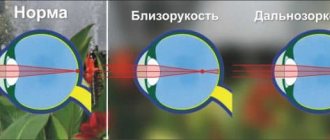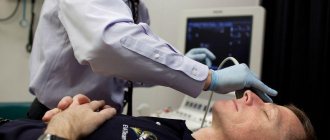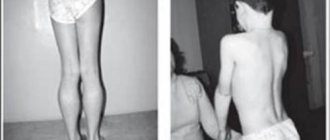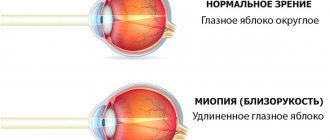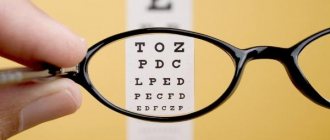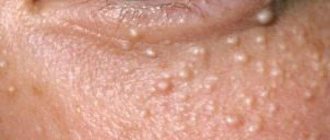Myopia or myopia is an eye disease in which a person sees well up close, but has difficulty seeing distant objects. According to statistics, 80% of the population of our planet suffers from various forms of myopia. The main part is due to a weak degree of myopia in one or both eyes. Without appropriate treatment, myopia can progress, causing a person to see worse and worse in the distance.
For some time, weak myopia can still be compensated by the functioning of the accommodation apparatus, which adapts the lens for normal distance and near vision. But over time, its compensatory lenses exhaust their ability to refract light rays and complications begin to develop, which ultimately lead to complete loss of vision.
A little about the disease
Myopia develops due to various anomalies in the structure of the eyeball or due to a violation of its ability to refract light rays. As a result, images of distant objects are focused not on the retina, as in a healthy person, but in front of it. This is why they are perceived as vague.
Mild myopia is defined by ophthalmologists as a range from -0.25 to -3 diopters. At this stage, glasses are not needed for constant wearing; a person needs them only during hard work associated with constant looking into the distance. A person's near vision is normal, but distant objects are seen in a blurry form, so they have to constantly strain their eyes. Every millimeter of growth in the eyeball increases the degree of myopia by -3 diopters.
The disease can progress. When vision decreases from -3 to -6, moderate myopia is determined. If vision falls below -6 diopters, ophthalmologists speak of a high degree of myopia.
Implantation of phakic lenses
This method of treating myopia is used in cases where natural accommodation has not yet been lost (the ability to clearly see both distant objects and nearby objects) and lenses can be implanted into the eye without removing the person’s natural lens. At its core, phakic lens implantation is similar to correction using contact lenses. The patient places only contact lenses on the cornea, while phakic lenses are implanted into the posterior or anterior chamber of the eye and the person’s natural lens remains in place.
The ophthalmic surgeon performs all manipulations through a self-sealing microaccess measuring 1.6 mm, which does not require sutures. After such surgery there is no need for hospitalization. The advantage of this technique is that with the help of phakic lenses it is possible to correct very high degrees of myopia (up to – 25 D).
Depending on the type of fixation in the eye, phakic lenses are divided into the following types: anterior chamber, posterior chamber, lenses fixed on the iris and fixed on the pupil . Today, the most commonly used lenses are posterior chamber phakic lenses. Read more about phakic IOL implantation.
Types of disease
Although the mild degree is initial, it can progress quite quickly. Often the disease actively develops in childhood. In turn, the weak degree is divided into several types.
Based on the nature of the course, the following forms are distinguished:
- stationary, in which myopia does not pass into another stage, but remains stable;
- progressive. Mild myopia progresses by one or more diopters per year;
- transient. Caused by taking certain medications or concomitant diseases;
- twilight A person sees poorly into the distance only after dark;
- malignant. A rapidly progressing form that can reduce vision by more than 20 diopters in a short time.
According to the development mechanism, a weak degree of myopia occurs:
- Axial. Develops due to enlargement of the eyeball.
- Refractive. It is caused by severe refraction as a result of thickening of the cornea or eye lens (lens);
- Mixed. It occurs due to the simultaneous influence of these two mechanisms.
According to the cause, the disease is divided into true and false. False myopia of the first degree or spasm of accommodation is a consequence of spasm of the eye muscles. Once the spasm is eliminated, vision is restored.
True myopia is caused by more serious reasons, the elimination of which takes much longer and the process is not always completed successfully.
Causes of low myopia
Mild myopia develops for various reasons, and depends on many, having a significant impact on vision.
You should know that this is a disease, the most common cause of which is heredity. If one of the parents has myopia, children will develop it in 25% of cases. If both mom and dad have myopia at the same time, the child will develop it in 50% of cases. Hereditary myopia manifests itself under the influence of negative factors in schoolchildren and students. The disease progresses until the age of 18, then remains unchanged until the age of 40-45.
Another reason is a weak accommodative apparatus, which causes rapid elongation of the eyeball.
It is affected by constant work at the computer or with small details, eye strain at school when reading and writing without rest.
How to cure moderate myopia
Treatment of moderate myopia consists of the following measures:
- selection of optical correction to restore quality of life: prescription of glasses or contact lenses;
- prescribing maintenance drug therapy, vitamins;
- surgical treatment.
Glasses and contacts do not eliminate average myopia, but allow you to see surrounding objects clearly. If a person wants to completely get rid of poor vision, then, in the absence of contraindications, he can do this through surgery. The most popular method today is laser vision correction using photorefractive keratectomy (PRK) or LASIK. The correction method is selected individually for each patient.
Optical correction of myopia
Myopia of the 2nd degree implies mandatory optical correction, since it creates serious inconvenience and imposes restrictions on lifestyle. For example, an adult cannot drive a car, a schoolchild cannot see what is written on the blackboard. Optical correction involves the use of lenses that will shift the eye's focus to the retina so that the image is clear.
It can be:
- Glasses. The selection of glasses should be carried out by an ophthalmologist using special equipment and a table to determine visual acuity. You cannot select glasses on your own: this can lead to even more serious eye health problems.
- Contact lenses. They also cannot be selected independently, even if the patient knows the number of diopters. Lenses also have other parameters that the specialist takes into account when selecting them.
- Phakic lenses. These lenses are placed directly inside the eye.
Optical correction does not cure myopia, but eliminates its consequences during the period of using glasses or lenses, allowing you to clearly see all surrounding objects and drive a car.
Medication method
It is impossible to cure moderate myopia with medications, however, as part of complex therapy, the patient is prescribed special vitamins and eye drops that help:
- relax the eye muscle;
- strengthen the walls of the blood vessels of the eye;
- activate blood circulation in the organs of vision;
- improve the condition of the retina and nervous tissue of the eye.
The intake of substances important for eye health into the body is extremely important for any degree of myopia, as well as for preventing its occurrence.
Surgical methods of correction
Surgical treatment can be aimed at either stopping the progression of the disease or completely ridding the patient of it. It all depends on age, the presence of complications and the progression of myopia.
If the patient is under 18 years of age and vision is rapidly deteriorating, scleroplasty surgery is used. It helps stop the further development of the disease by strengthening the sclera.
Laser vision correction is an effective and safe way to restore ideal vision with moderate myopia. This method is used in persons over 18 years of age with stationary (non-progressive) average myopia. The laser changes the shape of the cornea so that the image of distant objects is focused on the retina. This is a simple operation with a short recovery period and highly stable results.
Additionally, we invite you to read an article about operations for myopia.
Symptoms
At first, mild myopia does not manifest itself much. But as vision deteriorates below one and a half diopters, discomfort begins to appear when viewing distant objects.
Symptoms indicating low myopia are as follows:
- constant eye fatigue;
- you have to squint to look at distant objects;
- when reading or writing, there is a desire to bend over or get closer to the object in question;
- feeling of sand in the eyes after prolonged strain;
- dryness and redness of the organs of vision.
The presence of one or more signs for a long time is a reason to visit an ophthalmologist.
Prevention
The most effective preventive procedure is maintaining visual hygiene - after every hour spent in front of a computer monitor or television screen, you need to give your vision a rest for at least 15 minutes .
Preschool children should not watch TV for more than 45 minutes a day. For school-age children, the limit is 1.5 hours per day (the average length of a full-length film).
Other measures to prevent the development of myopia:
- Wearing sunglasses in sunny weather;
- “Physical exercise for the eyes” if you have a genetic predisposition to myopia;
- Correct selection of glasses and contact lenses prevents the development of progressive myopia;
- Proper, nutritious nutrition and intake of vitamins and microelements, especially those that strengthen the visual organs;
- Maintaining visual hygiene at home and in the workplace (sufficient lighting, alternating stress and rest);
- Regular visits to the ophthalmologist;
- Dosed exercises and sports (with the exception of some types);
- Healthy rest, sanatorium-resort therapy;
Diagnostics
To identify myopia, contact an ophthalmologist who conducts a visual examination and other diagnostic measures.
Before treating mild myopia, a number of diagnostic techniques are performed. They are reflected in the table.
| Method of diagnosis. | Description. |
| Visometry. | Vision test according to the table. |
| Ophthalmoscopy. | Fundus examination. |
| Tonography. | Checking the outflow of intraocular fluid. |
| Perimetry. | Determination of visual fields. |
| Ophthalmometry. | Determination of the optical power of the corneal layer of the eye. |
| Skiascopy. | Study of shadow movement in the pupil area. |
| Refractometry. | Testing the eye's ability to reflect light rays. |
| Tonometry. | Determination of intraocular pressure. |
| Ultrasonography. | Determining the length of the eyeball to determine possible pathology. |
Read in a separate article: Vitamins to improve vision in myopia
If after research it turns out that a person actually has a diagnosis of “low myopia,” then appropriate treatment is prescribed.
Treatment
Is it possible to cure low myopia? Mild stage myopia can be corrected very well. False myopia is eliminated by removing the spasm of accommodation.
Treatment of true myopia is carried out with vitamin therapy, optical correction, and surgery. In childhood, Sidorenko glasses are often prescribed. Select glasses with diverging lenses, with which you can shift the focus so that it falls on the retina.
For mild myopia, glasses are only needed when viewing distant objects. Glasses are made individually for each person after a thorough diagnosis, taking into account the distance between the pupils, the degree of myopia in both eyes or in one and other important parameters.
Important! Under no circumstances should you select and buy corrective glasses on your own without consulting a doctor. Wearing them will only harm your eyes, and myopia will progress.
Drug therapy is indicated for false myopia. Special medications (drops) are prescribed that relieve spasm of accommodation, which leads to the restoration of normal vision. Drops are prescribed if there is no progress of myopic processes, in the absence of the need for optical correction and other methods of treatment. Irifrin, Taufon, Ujala are often prescribed.
There are no medications to treat true myopia. Only vitamin complexes are used, which contain vitamins important for the eyes (retinol, riboflavin, pyridoxine, lutein).
Hardware correction techniques help well:
- Electrophoresis . Relieves eye tension, lowers intraocular pressure.
- Laser stimulator. Improves vision, eliminates eye fatigue.
- Color magnetic stimulator. Promotes the functioning of the optic nerve, eliminates eye spasms.
Treatment with hardware techniques is recommended every six months.
Therapeutic gymnastics also helps. The most effective exercises are considered to be intensive blinking for a couple of minutes, drawing a figure eight or a diamond with your eyes, moving your eyes up and down, left and right, vertically and horizontally.
When performing such gymnastics daily, the eye muscles relax, hypertonicity is eliminated, microcirculation in the vessels improves, metabolism is normalized, and degenerative processes are inhibited.
Absolute elimination of myopia is achieved by surgery - scleroplasty. It is carried out only with rapid progression of the disease. The most popular procedure is laser vision correction, in which myopia is corrected with a laser beam in 15 minutes.
Traditional medicine for mild myopia
Traditional methods of treatment for stage 1 myopia can be considered as additional measures to maintain eye health. It includes taking decoctions, infusions, and teas. You can take blueberries daily in all forms (frozen, fresh, in the form of fruit drink), tea from currant berries and leaves of this plant, infusion or syrup of rose hips.
Common nettle helps a lot. Its leaves in the amount of 50 grams are poured with a liter of boiling water and infused for 4 hours. Strain and consume 2 tablespoons before meals in the morning and evening.
All of the above natural medicines contain large amounts of vitamin C, as well as various micro and macroelements necessary for the eyes.
Myopia in children
Myopia is considered one of the most common ophthalmological diseases. In adolescence, moderate myopia is detected in 20% of children. But the disease begins to progress much earlier - at 9-12 years.
Myopia in children can be congenital, hereditary or acquired. Increased scleral extensibility contributes to the progression of the disease. Acquired moderate myopia is usually detected during an examination by a pediatric ophthalmologist. Teachers and parents can notice a deterioration in a child’s vision by his habit of squinting his eyes, blinking frequently, bringing objects close to his eyes, and going to the board to copy homework. Children see distant objects much worse, causing pain and pain in the eyes; children complain of physical weakness and increased fatigue.
To treat myopia in childhood, it is necessary to involve the best specialists and apply complex techniques. The prognosis for the future depends on the timeliness of seeking help.
With moderate myopia, glasses are used only for viewing distant objects. With the correct correction, vision will not deteriorate and you will not need to wear glasses all the time.
The most effective treatment methods are:
- drug therapy, vitamin-mineral complexes, vasodilators, instillation of drops that improve the nutrition of the child’s eyes;
- regular visual gymnastics;
- electrophoresis;
- massage of the cervical-collar area;
- acupuncture;
- laser therapy.
For high myopia, surgical scleroplasty is performed. It prevents stretching of the sclera and the development of the disease. Laser correction is used after 18 years.
Initial myopia during pregnancy
Pregnant women with stage 1 myopia should regularly visit an ophthalmologist. Usually, a mild degree of the disease during pregnancy does not pose a threat to the mother and baby, but if pathological changes are detected in the fundus, the question is raised about the advisability of a cesarean section.
During childbirth, a woman has to strain a lot, including the eye muscles, which can lead to detachment or rupture of the retina. There is a high risk of deterioration or even complete loss of vision. Carrying out a cesarean section eliminates pushing during childbirth and, accordingly, avoids complications from the visual organs.
Contraindications
It should be remembered that weak myopia of the right and left eyes is a disease prone to progression. Myopic people are not recommended to stay in very hot rooms (baths, saunas) for a long time. But extreme cold should also be avoided.
You should also think about choosing a profession. It should not be associated with visual overload. When engaging in physical exercise, you need to monitor your heart rate (it should not exceed 150 beats per minute).
It is quite possible to correct grade 1 myopia if you consult a doctor in time and follow all his recommendations.
